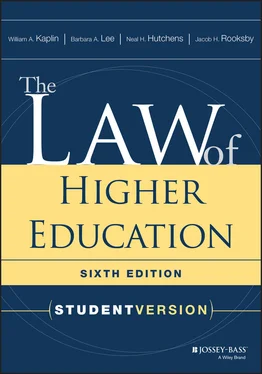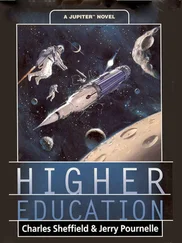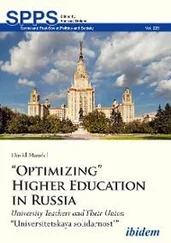Students may on occasion be regarded as agents of the institution, even if they are not employees. See, for example, Fils-Aime v. Ryder TRS, Inc. and Cornell University , 837 N.Y.S.2d 199 (N.Y. App. Div. 2007). The institution's liability for the acts of its agents is discussed in Section 3.1of this book and in various places in Sections 3.2through 3.4. Sections 4.5and 8.5discuss institutional liability for agents' acts under federal civil rights statutes.
2.1.4 Enforcement mechanisms.Postsecondary institutions may incur legal liability in a variety of proceedings. Students, employees, or others who believe that the institution has wronged them may often be able to sue the institution in court. Cases are usually (but not always) tried before a jury when the plaintiff claims monetary damages but are tried before a judge when the plaintiff seeks only equitable remedies such as an injunction.
Some federal statutes permit an individual to sue for alleged statutory violations in federal court, but if the statute does not contain explicit language authorizing a private cause of action, an individual may be limited to seeking enforcement by a federal agency. (See, for example, the discussion in Section 7.8.1 concerning private lawsuits under the Family Educational Rights and Privacy Act [FERPA].)
Various federal laws are enforced through administrative mechanisms established by the administrative agency (or agencies) responsible for that law. For example, the U.S. Education Department enforces nondiscrimination requirements under federal spending statutes such as Title VI of the Civil Rights Act of 1964, Title IX of the Education Amendments of 1972, and Section 504 of the Rehabilitation Act of 1973 (see Sections 11.5.2–11.5.4 of this book). Similarly, the federal Occupational Safety and Health Administration (OSHA) enforces the Occupational Safety and Health Act, and the U.S. Department of Labor enforces the Fair Labor Standards Act and the Family and Medical Leave Act. Administrative enforcement may involve a compliance review of institutional programs, facilities, and records; negotiations and conciliation agreements; hearings before an administrative law judge; and appeals through the agency prior to resort to the courts. Many states have their own counterparts to the federal administrative agency enforcement system for similar state laws.
Several federal statutes provide for lawsuits to be brought by either an individual or a federal agency. In other cases, a federal agency may bring constitutional claims on behalf of one plaintiff or a class of plaintiffs. The U.S. Department of Justice, on occasion, acts as a plaintiff in civil cases against postsecondary institutions. For example, the Department of Justice sued Virginia Military Institute (VMI) under the U.S. Constitution's Fourteenth Amendment for VMI's refusal to admit women (see Section 7.2.4.2). It also sued the state of Mississippi under Title VI of the Civil Rights Act of 1964 and the Fourteenth Amendment, seeking to desegregate the state's dual system of higher education (see United States v. Fordice , discussed in Section 7.2.4.1). The Justice Department acts as a plaintiff in antitrust cases as well (see, for example, United States v. Brown University , 5 F.3d 658 (3d Cir. 1993)). The Justice Department also plays a role in cases brought under the False Claims Act. Other federal or state agencies may also sue postsecondary institutions in court. Such litigation may follow years of enforcement actions by the agency and may result in fines or court orders to comply with the law.
Some institutions are turning to alternative methods of resolving disputes in order to avoid the time, expense, and public nature of litigation. Section 2.3discusses the use of mediation, arbitration, and other methods of resolving disputes on campus.
2.1.5 Remedies for legal violations.The source of legal responsibility determines the type of remedy that may be ordered if an institution or its agent is judged liable. For example, violations of statutes and administrative agency regulations may lead to the termination of federal or state funding for institutional programs, debarment from future contracts or grants from the government agency, audit exceptions, or fines. Violations of statutes (and sometimes regulations) may also lead to an order that money damages be paid to the prevailing party. Equitable remedies may also be ordered, such as reinstatement of a terminated employee, cessation of the practice judged to be unlawful, or an injunction requiring the institution to perform particular acts (such as abating an environmental violation). Occasionally, criminal penalties may be imposed. For example, the Occupational Safety and Health Act provides for imprisonment for individuals who willfully violate the act. Criminal penalties may also be imposed for violations of certain computer fraud and crime statutes.
2.1.6 Avoiding legal liability.Legal compliance should be thought of as the minimum that the institution must do and not as the maximum that it should do. Policy considerations may often lead institutional decision makers to do more than the law actually requires (see Section 1.7). The culture of the institution, its mission, the prevailing academic norms and customs, and particular institutional priorities, as well as the law, may help shape the institution's legal and policy responses to potential legal liability. To capture this dynamic, discussions of legal liability throughout this book are interwoven with discussions of policy concerns; administrators and counsel are often encouraged (explicitly and implicitly) to base decisions on this law/policy dynamic. Section 2.4discusses various strategies for managing the risk of legal liability.
2.1.7 Treatment law and preventive law.Institutions should give serious consideration to the particular functions that counsel will perform and to the relationships that will be fostered between counsel and administrators. Broadly stated, counsel's role is to identify and define actual or potential legal problems and provide options for resolving or preventing them. There are two basic, and different, ways to fulfill this role: through treatment law and through preventive law. To analogize to another profession, the goal of treatment law is to cure legal diseases, while the goal of preventive law is to maintain legal health. Under either approach, counsel will be guided not only by legal considerations and institutional goals and policies but also by the ethical standards of the legal profession that shape the responsibilities of individual practitioners to their clients and the public.
Treatment law is the more traditional of the two practice approaches. It focuses on actual challenges to institutional practices and on affirmative legal steps by the institution to protect its interests when they are threatened. When suit is filed against the institution or litigation is threatened, when a government agency cites the institution for noncompliance with its regulations, when the institution needs formal permission of a government agency to undertake a proposed course of action, when the institution wishes to sue some other party—then treatment law operates. Counsel seeks to resolve the specific legal problem at hand. Treatment law today is indispensable to the functioning of a postsecondary institution, and virtually all institutions have such legal service.
Preventive law, in contrast, focuses on initiatives that the institution can take before actual legal disputes arise. Preventive law involves administrators and counsel in a continual cooperative process of setting the legal and policy parameters within which the institution will operate to forestall or minimize legal disputes. Counsel identifies the legal consequences of proposed actions; pinpoints the range of alternatives for avoiding problems and the legal risks of each alternative; sensitizes administrators and the campus community to legal issues and the importance of recognizing them early; determines the impact of new or proposed laws and regulations, and new court decisions, on institutional operations; and helps devise internal processes that support constructive relationships among members of the campus community. Prior to the 1980s, preventive law was not a general practice of postsecondary institutions. But this approach became increasingly valuable as the presence of law on the campus increased, and acceptance of preventive law within postsecondary education grew substantially. Today, preventive law is as indispensable as treatment law and provides the more constructive overall posture from which to conduct institutional legal affairs.
Читать дальше












